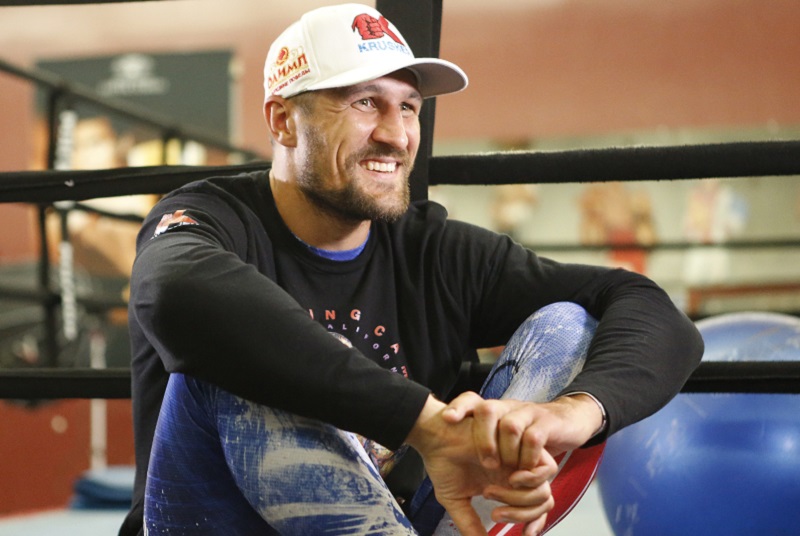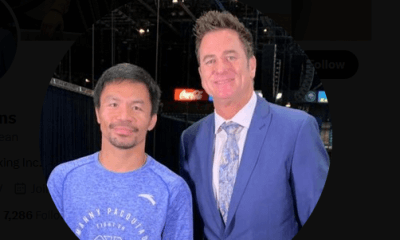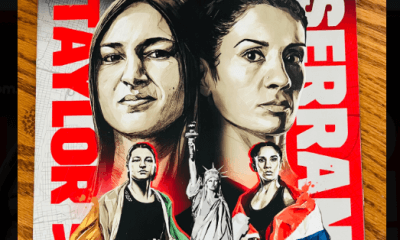Featured Articles
Kovalev’s Transformation Suggests an Old Truism Might Not be so True Anymore

It has long been axiomatic in boxing that the last attribute any aging fighter loses is his punching power. As Exhibit A, see George Foreman, but then Big George is hardly alone in that regard. Ring history is rife with examples of veteran masters of blunt-force trauma who have remained at least somewhat relevant despite the inexorable march of time. A well-placed shot, if hard enough and delivered with bad intentions, can camouflage and even erase any number of mounting deficiencies in a bout that only seconds earlier might have appeared to be slipping away.
But there is recent evidence to suggest that maybe that hoary old truism isn’t so true anymore. Maybe the reverse is even possible. If the ability to instantly chill an opponent is more perishable than previously imagined as a big bopper moves toward and even beyond the outer limits of his prime, perhaps it can be replaced in part by guile, tactics and an acknowledgment that the willing acceptance of change is not necessarily tantamount to weakness.
It remains to be seen whether the version of Sergey “Krusher” Kovalev that was on display late Saturday night – or very early Sunday morning, for viewers in the Eastern time zone — is actually new and improved or merely different. But until more evidence is available, the clear-cut points victory for Kovalev (33-3-1, 28 KOs) over Eleider “Storm” Alvarez (24-1, 12 KOs), the man who had brutally taken his WBO light heavyweight title on a seventh-round knockout six months earlier, at least demonstrated that it is possible to teach a recalcitrant old dog a few tricks he hadn’t had to resort to much in the past.
“For me it doesn’t matter who’s next,” a smiling Kovalev, who turns 36 on April 2, said when asked what his next move would be after he captured the WBO version of the 175-pound title for a third time before a live crowd of 4,877 and an international ESPN+ viewing audience at the Ford Center at the Star in Frisco, Texas, the training facility of the Dallas Cowboys. “Who’s ready for a unification fight? I’m here to make history for me and my fans. I want to fight the champions in my division. Any fighter who is ready.”
It is not so much that Kovalev won as the manner in which he did. Had he nailed the favored Alvarez hard and early, as the Russian bully boy had done in putting away so many previous opponents who did not come close to matching his firepower, that would have been one thing. But Kovalev’s reputation as the baddest man on the planet, 175-pound division, began taking hits in and out of the ring beginning with his back-to-back losses to Andre Ward, even though there were more than a few observers who believed he had done enough to get the nod in their first fight, which Ward won on a razor-thin unanimous decision on Nov. 19, 2016 (all three judges had it 114-113). Some of the negative whispers that attached themselves to Kovalev – that he was racist, a problem drinker, an abrasive personality who did not heed the advice of his trainer do jour, be it John David Jackson or Abror Tursunpulatov – had the effect of depicting him as a fighter whose best days were already behind him, or soon would be unless he found a way pull out of his downward spiral.
Ward, for one, had publicly dismissed Kovalev as a six-round fighter whose gas tank would drain quickly if he obliged to labor into the middle and later rounds, a premise that seemingly was verified when, well ahead on all three official scorecards in his first fight with Alvarez, he was floored three times in round seven and was stopped. The consensus heading into the rematch was that another such loss would render the “Krusher” irrelevant, a non-factor in a division that was steadily moving beyond him.
To some, Kovalev’s attempts to reinvent himself post-Alvarez smacked, well, of desperation. His replacement of Tursunpulatov with McGirt, the 2002 Boxing Writers Association of America Trainer of the Year who in June will be inducted, as a fighter, into the International Boxing Hall of Fame? Nothing to get particularly excited about; hadn’t he blamed his previous trainers for his more recent missteps? Of more concern to the boxing cognoscenti was the high-speed crash of Kovalev’s Mercedes while back home in Russia and the pilgrimage he undertook to a monastery on Greece’s Mount Athos ostensibly in search of some form of inner peace.
As if all that weren’t enough, things got worse in the run-up to the do-over with Alvarez. On Jan. 18, TMZ Sports published a report that Kovalev had been arrested on a felony assault charge stemming from a June 9 incident in Big Bear Lake, Calif., in which he was accused of punching a woman in the face after she rejected his sexual advances. Kovalev is due in court in March for a preliminary hearing on the matter.
But all the doom-and-gloom projections for Kovalev, who already was being consigned by some to the dust bin of boxing history, might have been premature. He proved surprisingly amenable to the revisions proposed by McGirt and new strength-and-conditioning coach Teddy Cruz, with whom Kovalev’s longtime promoter, Main Events CEO Kathy Duva was familiar, through their work in smoothing some of the late Arturo Gatti’s rougher edges more than a decade and a half ago. And who knows, maybe the unidentified monk on the mountain imparted some words of wisdom that touched Kovalev in a manner that proved more uplifting than any standard locker-room pep talk ever could.
Duva is confident that Kovalev’s legal issues can be resolved expeditiously, leaving him with enough of an unencumbered mind that he can focus on the task of again creating another reign of light heavyweight terror, albeit one that isn’t quite so reliant on the swift and savage put-away. There are different ways for a fighter to impose his will on the other guy, and it will be interesting to see how long Kovalev can be satisfied with the slow ’n’ steady building-block approach espoused by McGirt in contrast with the wrecking-ball method that once served him so well.
Both on the scorecards – Kovalev came out ahead 120-108 and 116-112 (twice) – and in the punch statistics, which saw him outland Alvarez by 213 of 816 (26 percent) to 111 of 369 (30 percent), the Russian fought with impressive constraint and control. It would be unwise to dismiss him out of hand as a threat to the other reigning light heavy titlists, the WBC’s Oleksandr Gvozdyk (16-0, 13 KOs), WBA’s Dmitry Bivol (15-0, 11 KOs) and IBF’s Artur Beterbiev (13-0, 13 KOs). Former WBO super middleweight champ Gilberto “Zurdo” Ramirez (39-0, 25 KOs), who has announced his intention to move up to 175, also is an interesting name in the mix.
Photo credit: Craig Bennett / Main Events
Bernard Fernandez is the retired boxing writer for the Philadelphia Daily News. He is a five-term former president of the Boxing Writers Association of America, an inductee into the Pennsylvania, New Jersey and Atlantic City Boxing Halls of Fame and the recipient of the Nat Fleischer Award for Excellence in Boxing Journalism and the Barney Nagler Award for Long and Meritorious Service to Boxing.
Check out more boxing news on video at The Boxing Channel
To comment on this article in The Fight Forum CLICK HERE
-

 Featured Articles3 weeks ago
Featured Articles3 weeks agoVito Mielnicki Jr Whitewashes Kamil Gardzielik Before the Home Folks in Newark
-

 Featured Articles4 days ago
Featured Articles4 days agoResults and Recaps from New York Where Taylor Edged Serrano Once Again
-

 Featured Articles1 week ago
Featured Articles1 week agoFrom a Sympathetic Figure to a Pariah: The Travails of Julio Cesar Chavez Jr
-

 Featured Articles3 days ago
Featured Articles3 days agoResults and Recaps from NYC where Hamzah Sheeraz was Spectacular
-

 Featured Articles4 weeks ago
Featured Articles4 weeks agoCatching Up with Clay Moyle Who Talks About His Massive Collection of Boxing Books
-

 Featured Articles1 week ago
Featured Articles1 week agoCatterall vs Eubank Ends Prematurely; Catterall Wins a Technical Decision
-

 Featured Articles4 days ago
Featured Articles4 days agoPhiladelphia Welterweight Gil Turner, a Phenom, Now Rests in an Unmarked Grave
-

 Featured Articles3 weeks ago
Featured Articles3 weeks agoMore Medals for Hawaii’s Patricio Family at the USA Boxing Summer Festival



















